JASON BALDES leans against his dad’s red Toyota 4-Runner, two long braids draped over a T-shirt that reads “Make Buffalo Great Again.” Richard Baldes sits in the driver’s seat, silver hair poking out from under his Buffalo Bills hat. It’s a tribute to the animal, but also to former University of Wyoming and current Bills quarterback Josh Allen. The Baldeses talk about Jason’s travel schedule (too busy, according to his dad), long-ago trips to Africa (formative for them both), and hunting buffalo (Richard doesn’t want to shoot one, Jason longs to do so on a traditional hunt).
Father and son, both members of the Eastern Shoshone Tribe, stare out at a sea of green grass and buffalo berry bushes as a herd of 30 or so bison munch patches of grass, flick their tails at flies, and flop onto the ground, creating brief billows of dust. A bigger bull runs off a small one (though the “small” one still weighs more than 1,000 pounds) with a quick charge and a grunt. A pronghorn buck lopes along the hillside behind us.
For much of the last century, bison were absent from this yawning expanse of mountain and prairie in central Wyoming. Pronghorn were largely gone, too. Bighorn sheep existed in a few isolated pockets. Even mule deer and elk were running low. People mostly hunted cottontails, the last game that existed in any quantity.
It may well have stayed that way with bison and many other animals if not for Richard, and now Jason. But controversial species restoration takes its toll: Richard nearly lost his job and faced death threats in his quest to recover pronghorn, bighorn sheep and other big game. It can also be lonely: Few models existed for the thankless work Richard shouldered. Jason, meanwhile, is creating a framework for restoring bison to tribal lands across the country. Because when it comes to buffalo—a keystone species both for the ecosystem and for their people—there remains much work to do.
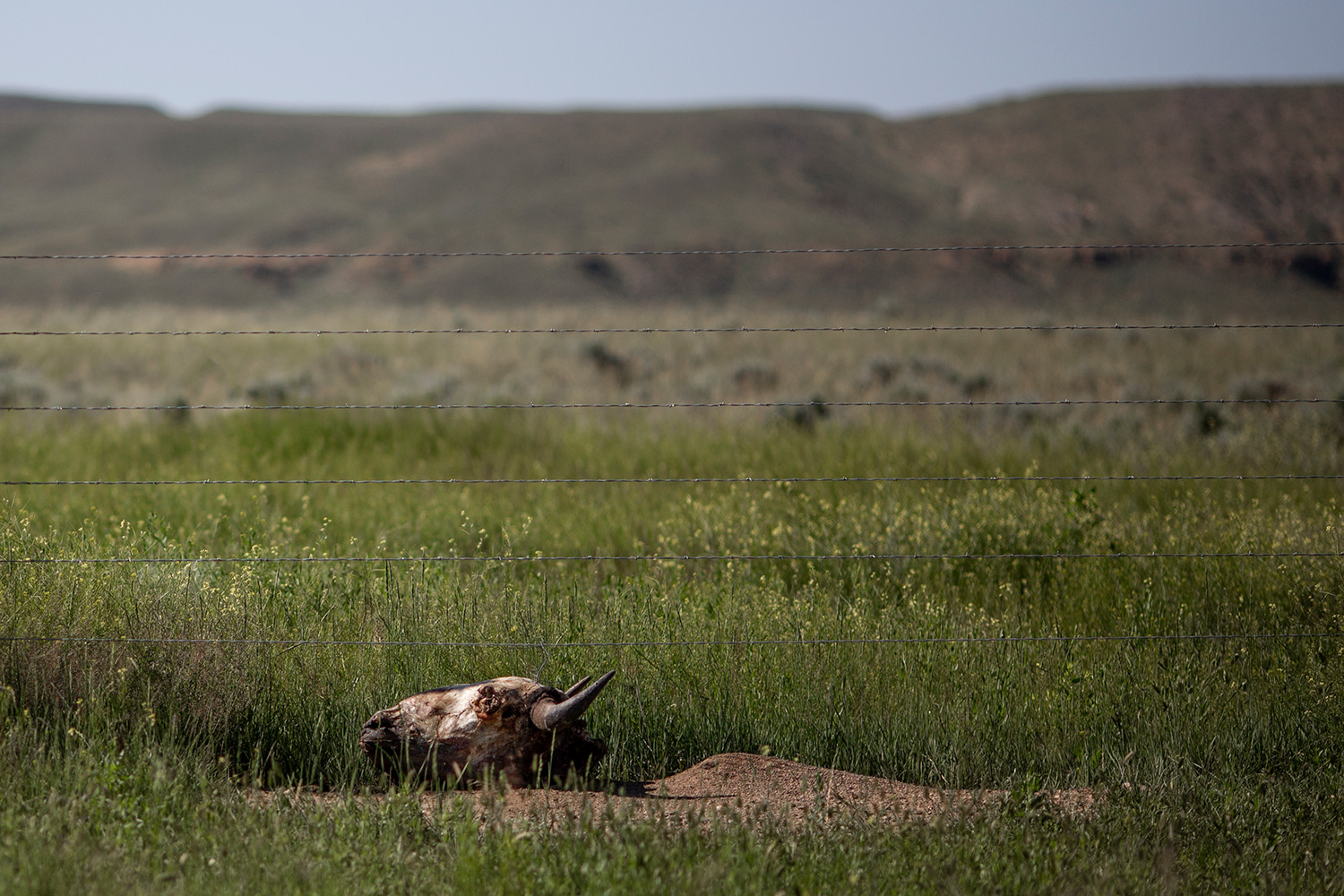
Why risk their futures, their livelihoods and even their lives for wildlife? For the Baldeses, it’s not complicated. Without wild game there is no hunting, which has been a part of their people’s identity since the beginning of time. Someone had to do it. It might as well have been them.
The Boom and Bust of the Buffalo
The land where Jason and Richard stand, ringed by some of Wyoming’s highest peaks, is at the edge of the 2.2-million-acre Wind River Indian Reservation, the seventh-largest reservation in the country. The Eastern Shoshone Tribe’s ancestral territory encompassed not only this modern swath but a massive chunk of the Western U.S.
In an 1868 treaty with the U.S. government, the Shoshone agreed to settle on a reservation of more than 44 million acres across Utah, Colorado, Idaho, Montana, and Wyoming. But five years later, the federal government reduced that reservation by almost 42 million acres to its current size “because of gold in California and people moving across the country,” says Richard. “They didn’t want problems with Indians, so they just took the land.”
And just as their land was taken, so too was the source of food and life for the Eastern Shoshone, who call themselves Gweechoon Deka, or the Buffalo Eaters. Bison once roamed much of the U.S. from Canada to Mexico and New York to Oregon. As many as 60 million moved in waves across the plains, creating habitat for everything from beetles and butterflies to grizzly bears and wolves.
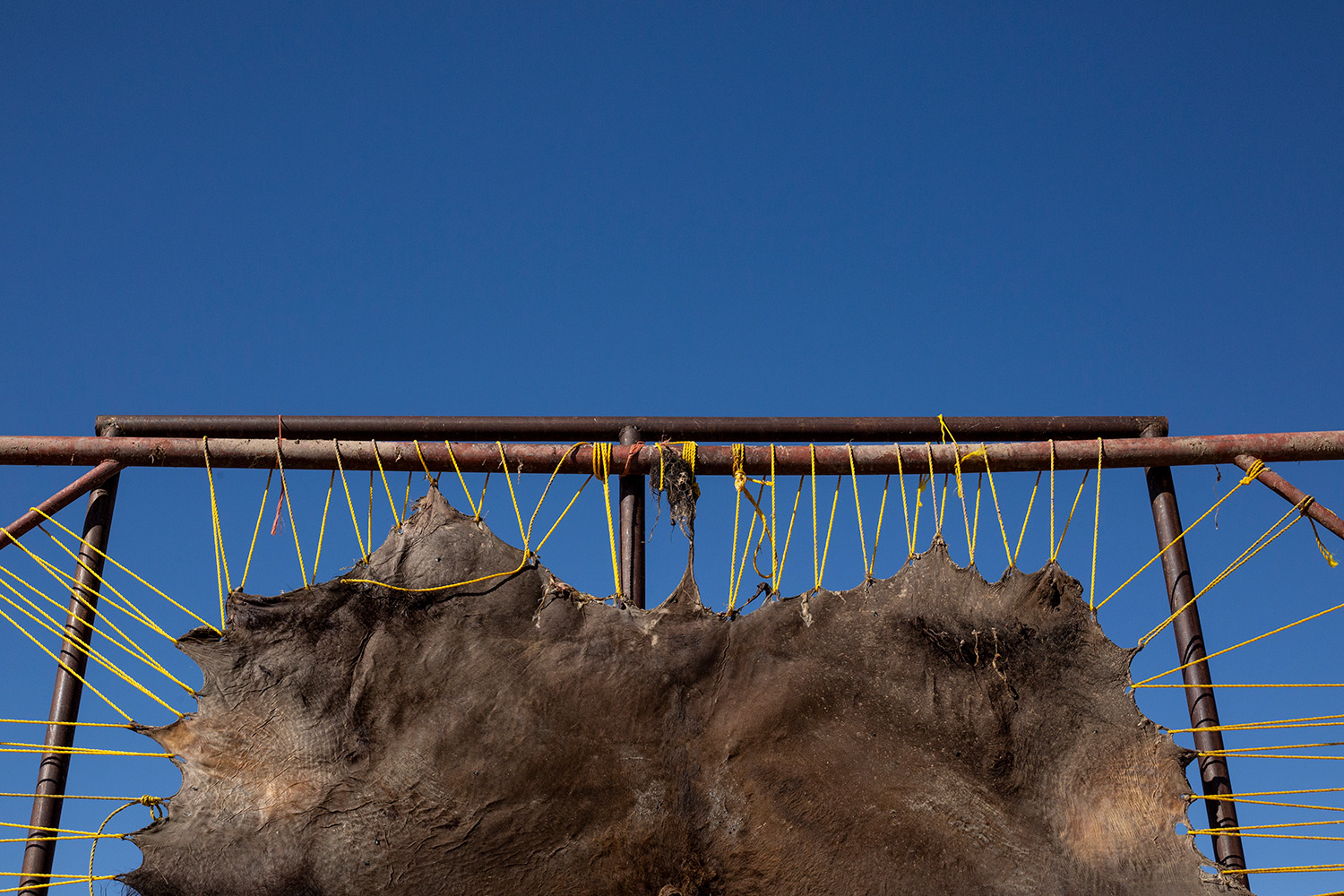
But white settlers found their stubborn dispositions too unruly for domestication and their big bodies too tempting a commodity. And so the buffalo were butchered and sold for their tongues and hides, and their bones were ground and used for fine china. They were slaughtered by the millions to make way for an expanding railway system, to clear land for domestic cattle, and as part of a directive from the U.S. Army to subdue the West’s native peoples. Generals William T. Sherman and Philip Sheridan “viewed the eradication of the buffalo as the ‘critical line of attack’ in the struggle with the Plains Tribes.” The slaughter was so vast, as one railway engineer famously commented, that “it was possible to walk 100 miles along the Santa Fe railroad right-of-way by stepping from one bison carcass to another.”
By the late 1870s, bison in the southern portion of the U.S. had been all but eliminated, and by the mid-1880s, just a thousand wild buffalo remained. “The destruction of the buffalo herds, and the associated devastation to the Tribes, disrupted the self-sufficient lifestyle of Tribal people more than all other federal policies to date,” wrote the InterTribal Buffalo Council.
But then the symbol of the American West, today emblazoned on everything from license plates to mugs to Wyoming’s state flag, started clawing their way back in domesticated and free-ranging herds. In 1991, the InterTribal Buffalo Council formed to restore buffalo in a coordinated way on tribal lands. The federally chartered Indian Organization now includes more than 80 tribes spread across 20 states, and tens of thousands of buffalo occupy those lands as well as private parcels like the American Prairie nature reserve in Montana.
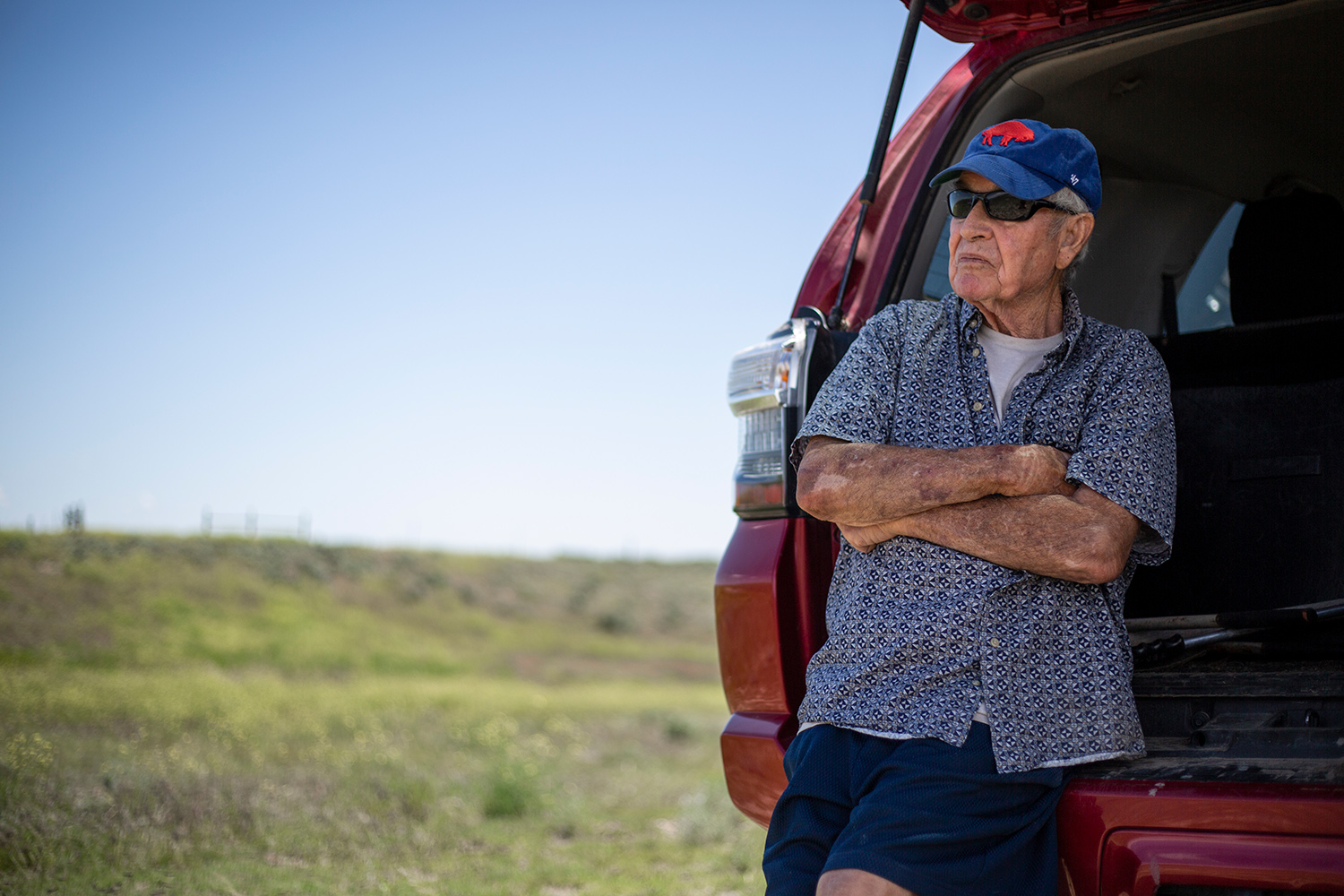
One problem with modern American society, argues Jason, is the disconnect between food and where it comes from. And even for many of the Eastern Shoshone and Northern Arapaho—the tribes living here on the Wind River Indian Reservation—that relationship had been lost.
But Richard and Jason believed buffalo, and other wildlife that had all but disappeared, could be restored. And in doing so, perhaps they could restore their peoples’ connection with food, the land, and their ancestors.
An Uphill Battle
Richard Baldes, 81, doesn’t really want to talk about the time someone shot his trailer in broad daylight while his family ice-fished for burbot, or the times he almost got fired, or the unpaid suspensions he was given because he spoke his mind and rubbed the wrong people the wrong way. He’d rather talk about catching cutthroat trout on the fly with his dad before fly fishing was cool, or about hunting cottontails.
But stories about growing up on the reservation in the ’40s and ’50s lead back to those memories of getting flak at work and bullet holes in his trailer.
“Occasionally my dad would get an antelope, but south of here. There were no antelope here,” he says, gesturing to the tribal lands in front of him ringed by mountains as far as we can see. “Deer hunting was OK.”
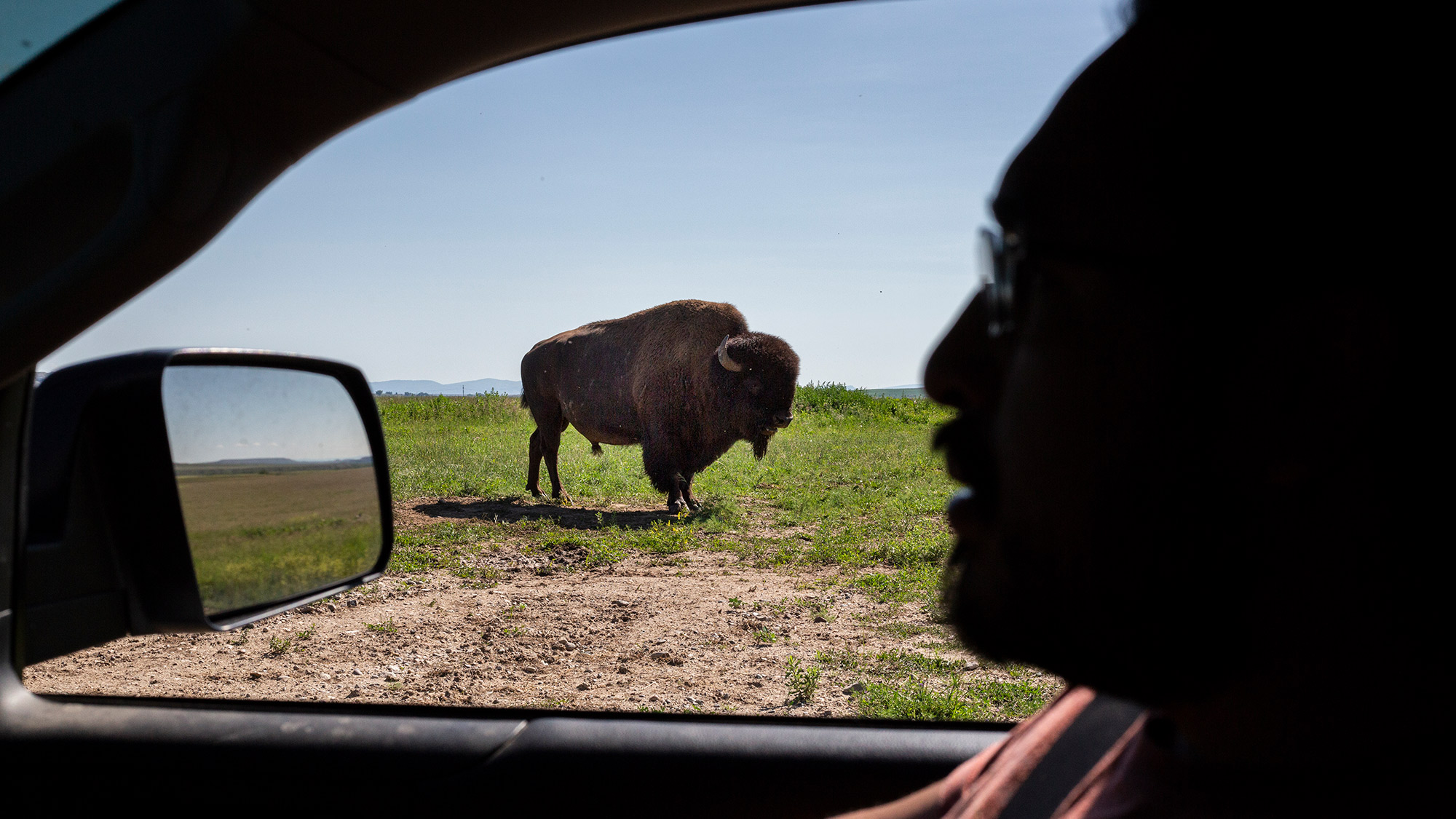
And then even the deer numbers weren’t OK. The reservation didn’t have a tribal game code in the mid-1900s; few did. And with no buffalo for food, unregulated hunting of everything else overtook the rest of the wild game.
Richard left the Wind River Indian Reservation after high school, studied wildlife management in college, earned his master’s in fisheries in Colorado, then worked for state and federal agencies in Montana and Arizona. He knew he wanted to come home, though, and in 1972, Richard became the Fish and Wildlife Service Project Leader on the reservation.
The reservation’s millions of acres cover and border terrain from rivers and grasslands to high alpine systems, including the largest contiguous glacial complex in the lower 48. It didn’t take long after Richard returned home for him to realize what had to happen. The tribes needed their wild game back, but how people hunted that game had to change first.
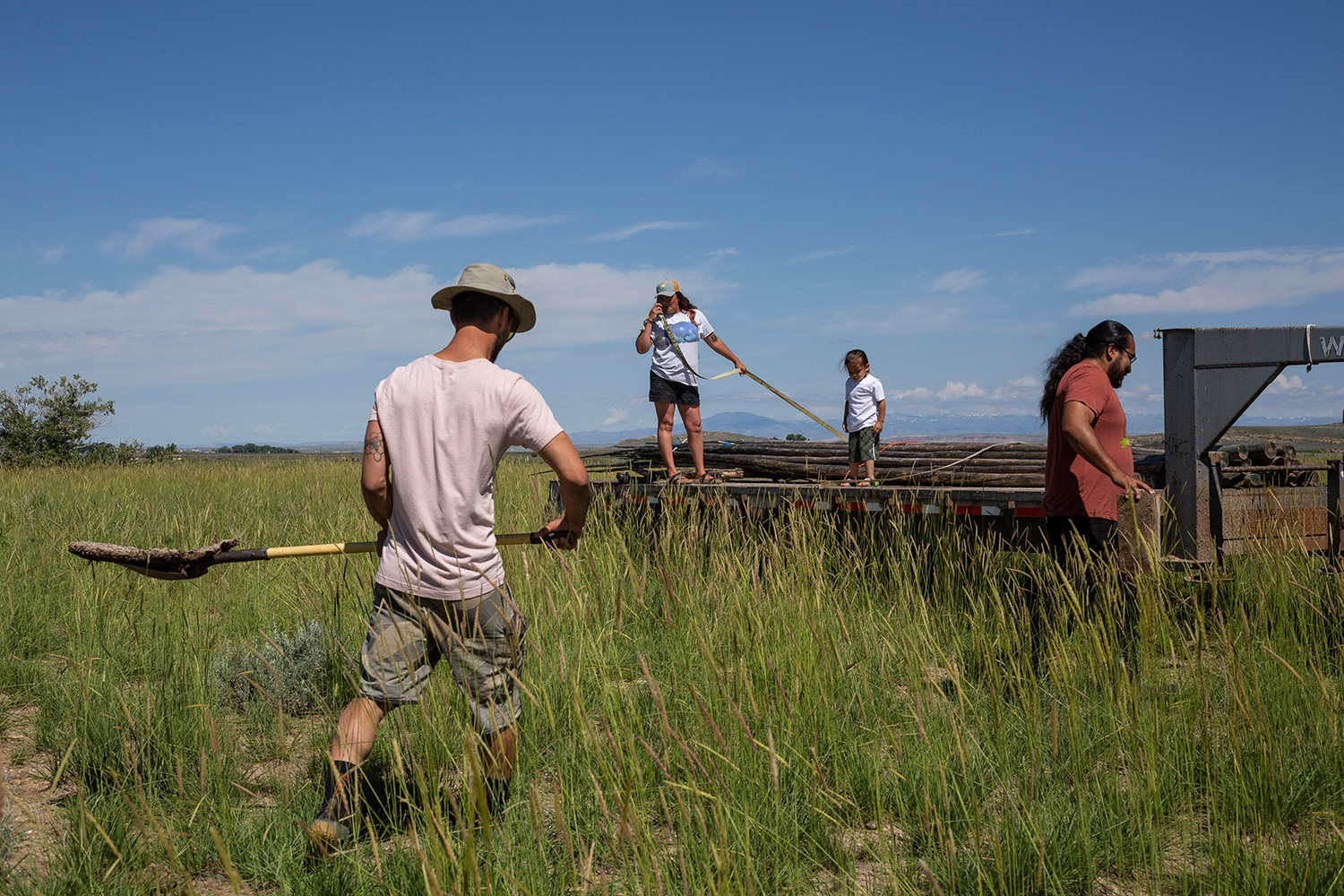
“You can’t hunt [without game codes] forever with the best vehicles in the world, and the best rifles and the best equipment,” he says. “It caught up to us.”
So for years, Richard worked with the Shoshone and Arapaho tribes and people like Tom Dougherty, the former president of the Wyoming Wildlife Federation and longtime senior advisor to the National Wildlife Federation, to establish hunting, fishing, and trapping regulations on the reservation.
While many tribal members wanted a game code, some really didn’t, and one winter day, Richard and his family returned from an ice-fishing trip to find bullet holes in their trailer.
“I don’t know if they knew we weren’t there, but there easily could have been someone inside,” he says.
Still, he continued his work to regulate hunting. And in 1984, the tribes signed one of the first tribal game codes in the country. Not long after, Richard and Shoshone and Arapaho tribal council members unlatched the doors of a modified horse trailer housing almost two dozen pronghorn and watched the antelope bound out and onto the reservation land.
“When we first brought pronghorn antelope back, my dad said, ‘You’re going to be hunting antelope in 10 years,’” Jason says. “They did so well, I killed my first antelope eight years later, and I’ve killed one almost every year since then. I witnessed bighorn sheep brought back in by train through Wind River Canyon, and that should have been the same way buffalo were brought back.”
“There’s absolutely no question that the beginning of biological recovery [of the Wind River Indian Reservation] was initiated by Richard,” Dougherty says.
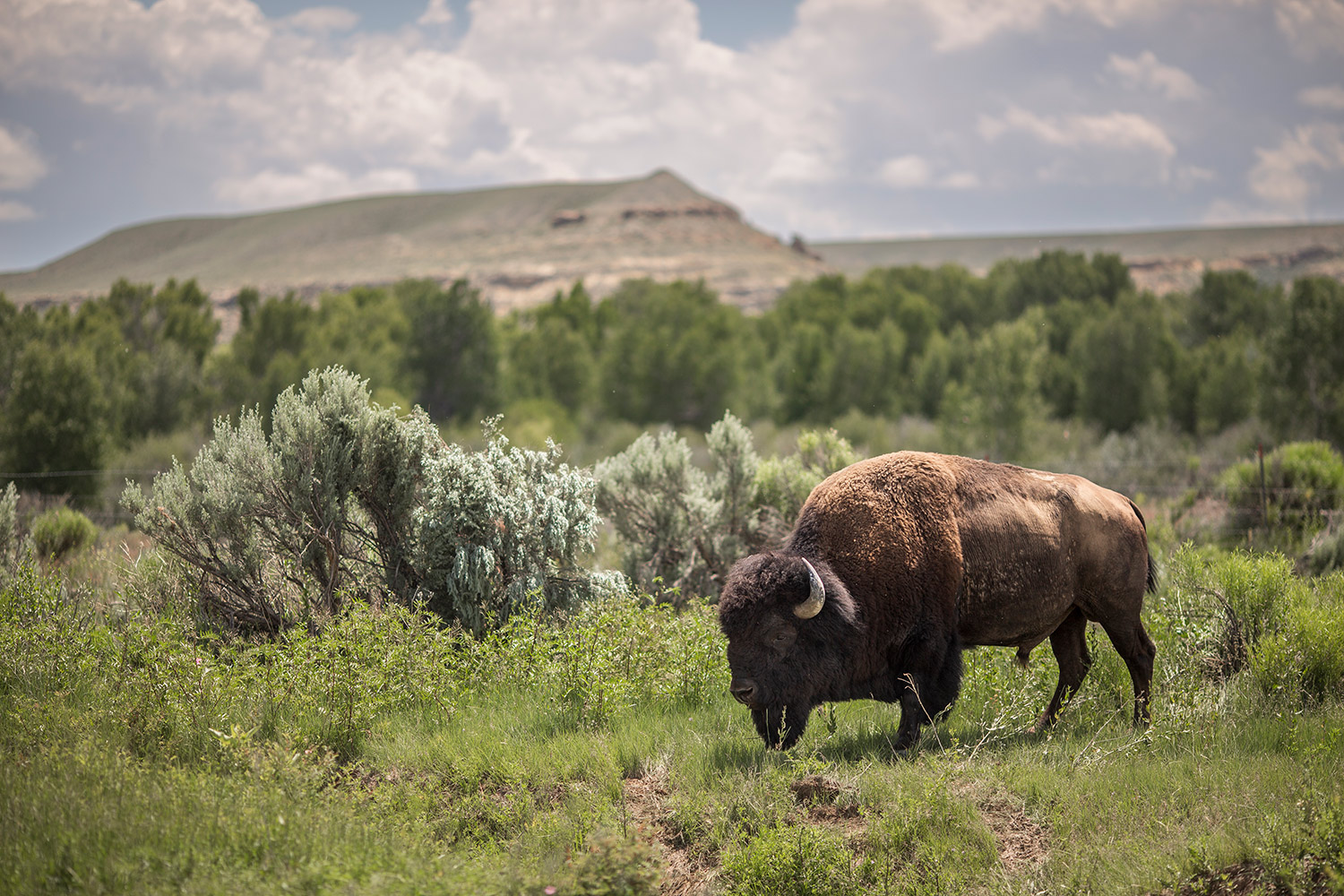
After his work with wildlife, and after fighting to keep water from being siphoned from the rivers in the Wyoming water wars of the 1980s, Richard was tired.
But there was still much work to be done when it came to bringing back the iconic buffalo. And so Jason, who was in his early 20s and contemplating graduate school, found a mission of his own.
Revelations
“There’s a good one right over there,” Jason says one hot day in late June, pointing to a flat, gray buffalo turd nestled in the grass. “You don’t need a shovel. Just pick them up.”
“I’ll break them if I pick them up with my hands,” says Christopher Flanagan, a volunteer who raises money for restoration efforts. Today, he’s collecting buffalo chips to be used for ceremonies at the upcoming Arapaho Sundance.
“That’s why you don’t want the ones that break,” Jason replies, noting that the perfect chip is gray and sun-bleached. “It’s why you want the 3-to-4-year-old ones, not the 8-to-10-year-old ones.”
Jason doesn’t mince words about anything, not about collecting the right turds, the importance of buffalo, or the long road it’s taken to get here.
Even as a kid, Jason knew something was missing. He wanted to hunt buffalo, which meant buffalo herds needed to be restored. But he didn’t know that this desire would chart his life’s course.
“In high school, I took woodshop and auto shop, and I had the afternoons off,” he says. “I didn’t really have any intention of going to college.”
He didn’t have many plans at all. And like plenty of other dads of aimless 18-year-olds, Richard thought his son needed direction. So he took Jason on a trip to Kenya and Tanzania to visit major national parks. He wanted his son to see what abundant wildlife looked like.
“The wildebeest migration was an epiphany for me. We drove for under 100 miles and as far as we could see, there were wildebeests and lions, hyenas, gazelles, impalas, zebras, giraffes—everything,” Jason says. “And then realizing that was less than 5 percent of the buffalo that were here not 200 years ago was unfathomable.”
That’s how, Jason says, “I found a purpose.” By his mid-20s Jason and his wife, Patty, and their family moved to Bozeman, Montana, where he would study environmental science.
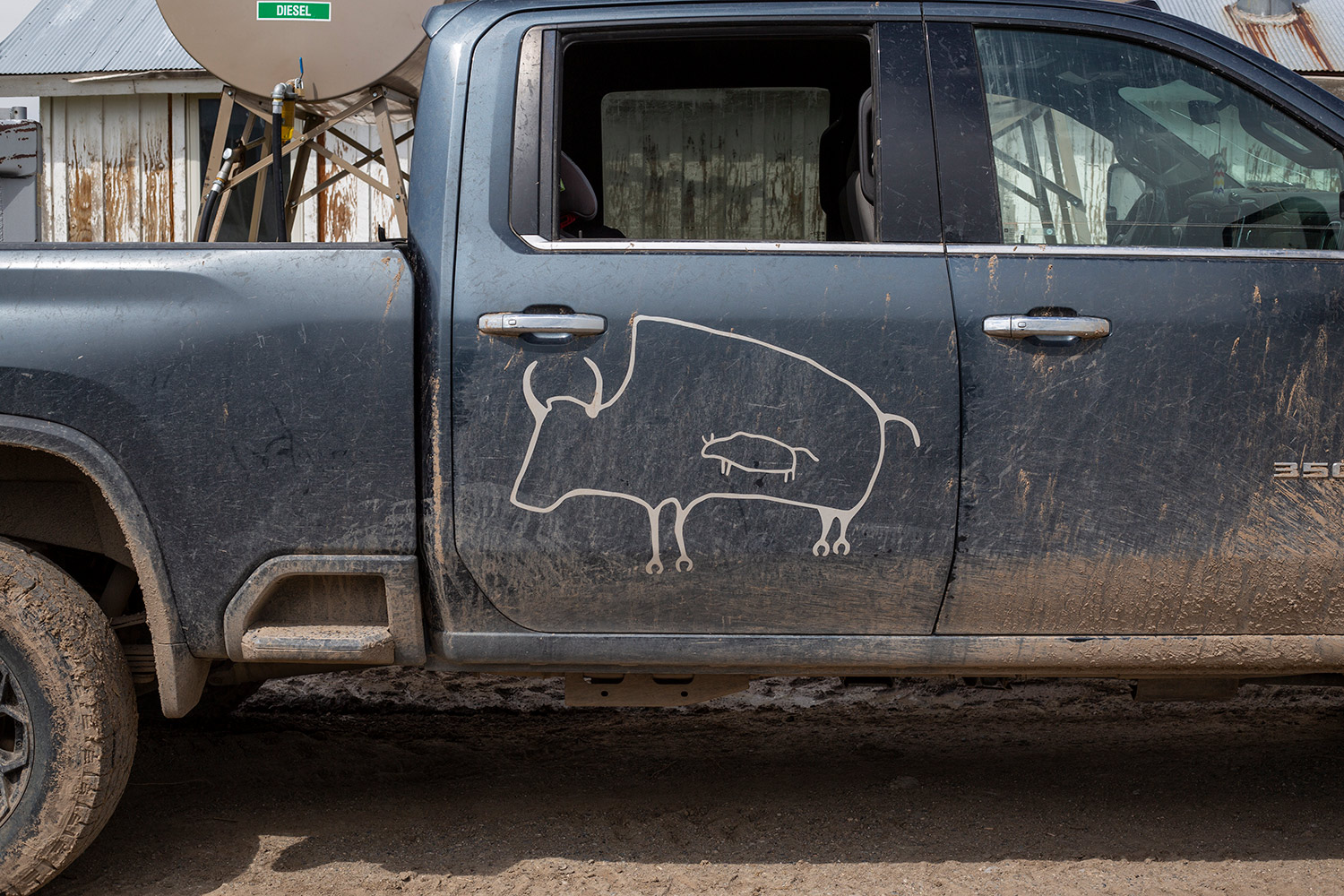
But restoring a nearly lost animal that can weigh 2,000 pounds and does largely what it wants isn’t an easy road. Ranchers across the West have fought, and continue to fight, bison restoration on public and even private lands. They fear grazing competition and the spread of diseases like brucellosis (though no case has ever been recorded of a bison transmitting brucellosis to cattle).
Even on the reservation, Jason, Eastern Shoshone like his dad, and Patty, a member of the Northern Arapaho Tribe, faced challenges to the idea from cattle ranchers both Native and nonnative. So they went to endless meetings and sat with people and talked. They went into schools, just like Richard had as he worked on shoring up support for a game code and water rights. They talked to kids about their cultures’ connections to buffalo and how buffalo used to be key to keeping the ground healthy—and could again if they were restored. Buffalo spread native seeds in their shaggy coats, create pools of water where they wallow, aerate the ground with their hooves, and graze so sporadically that no single area loses all its grass to their appetites.
Those kids went home and nagged their parents. And slowly, patiently, minds started to change. One night in 2016, 10 buffalo from the Neal Smith National Wildlife Refuge in Iowa were released into a corral owned by the Shoshone Tribe. There they stayed for three days before Jason and other Shoshone members opened the corral gates and the buffalo stepped out onto the Wind River Indian Reservation. Three years later the Northern Arapaho relocated bison to begin their own herd.
“Jason and I look at each other sometimes, and we don’t really feel like we even had a choice,” Patty says. “Like the buffalo almost chose us. They got here in 2016, and I truly met a part of myself I didn’t know was there.”
Jason then formed the Wind River Tribal Buffalo Initiative to buy back allotted lands for buffalo that had been taken when the reservation was opened for settlement. He also began the painstaking process of encouraging tribal leadership to change land-use designations from cattle to buffalo range in certain areas. This July, the tribes agreed to add 17,000 acres of tribal land available for buffalo to roam. It will ultimately connect both tribe’s herds.
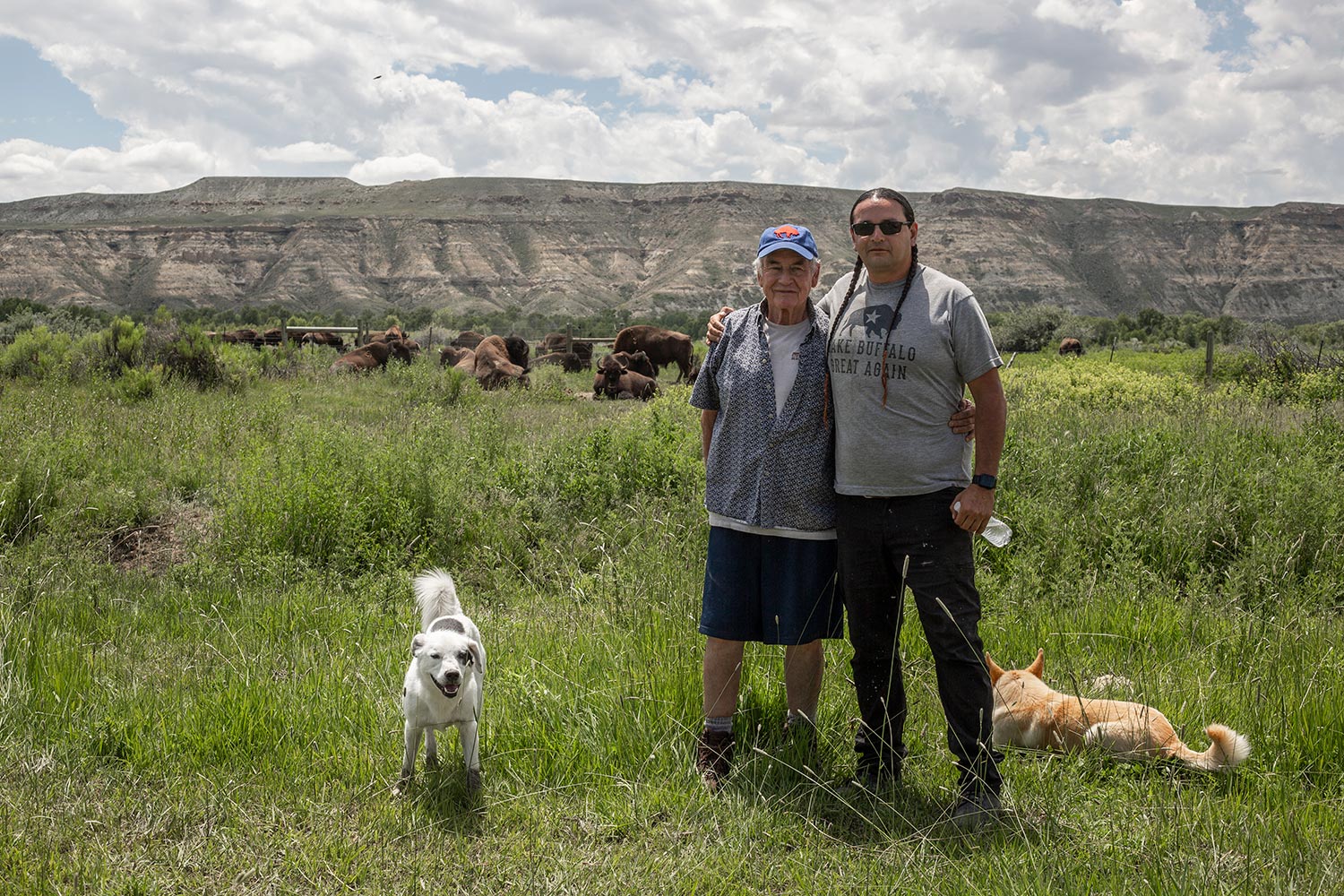
Richard never told Jason what to do. He didn’t tell him to restore buffalo or even to work with wildlife. But he did give one piece of advice that Jason took to heart.
“He said, ‘Don’t work for federal government. Don’t work for state government, and don’t work for tribal government,’” Jason says. “He recognized from his own complications that more could be accomplished not working under those systems.”
That’s how Jason came to form the Buffalo Initiative. On LinkedIn, his job description simply reads: “Puttin Buffalo back.” Now he and Patty live near the Shoshone buffalo herd, which includes 91 animals. The couple can see them out their back door. The Arapaho herd, which isn’t too far away, has 73.
In 2018, Jason killed a 4-year-old bull, the first buffalo harvest in recent history on the Wind River Indian Reservation. The occasion was momentous but it was still a kill, says Jason—not a hunt. The buffalo aren’t roaming freely like they did 200 years ago. They’re behind fences.
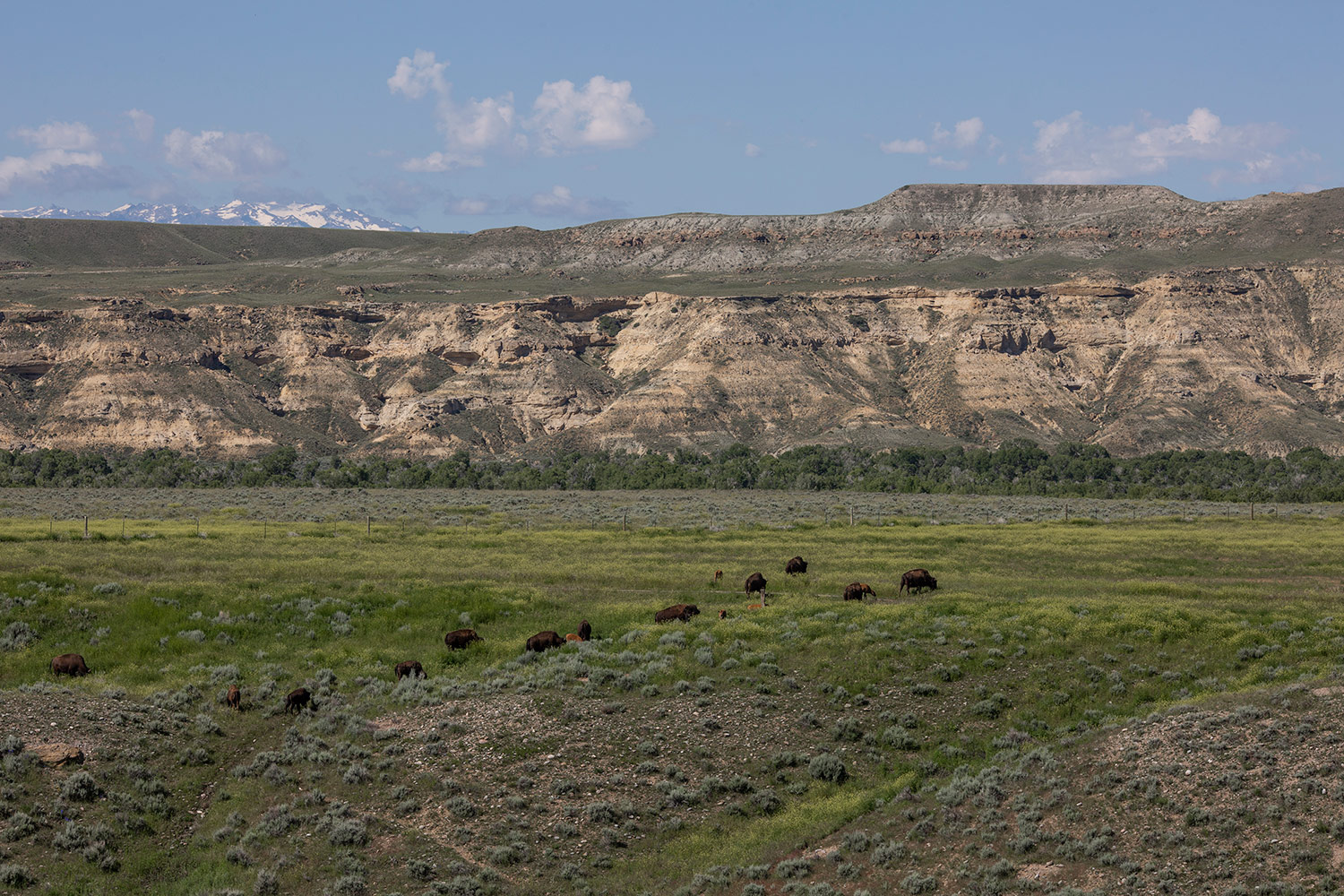
And ultimately, the point isn’t to just have a few bison back on the reservation here and there. The point is to have enough free-ranging bison to provide tribal members with the hunts, the food, and the presence that connect them to their ancestors. This year, for the first time in 139 years, the Shoshone Tribe harvested three buffalo from Shoshone land for their three Sundances.
“It’s an honorable thing to be able to take the life of a buffalo and feed your family with it,” Jason says. “But it feels more appropriate when you’re taking that animal when it’s living life the way that it should and not in a 2,000-acre enclosure.”
“An American Story”
The bison we spent hours watching have moved on. Now they’re behind buffalo berry bushes and in tall grasses, heading toward the setting sun. Richard explains that he looks forward to joining his son on a hunt one day, but at his age, he just isn’t sure he would want to pull the trigger. Jason understands his dad’s feelings, but he has no such misgivings.
“Well, I eat buffalo quite a bit,” Jason says.
“Well, I eat buffalo quite a bit, too,” Richard replies. Even now there’s a roast thawing in his refrigerator at home.
“It’s taking the life of one that is hard to do, but it’s necessary,” Jason says. “That’s part of the reciprocal relationship we’ve had with them. We love them and revere them, but we also kill them and eat them and use them and honor their parts.”
The stories Richard and Jason tell are about wildlife and their people, but they’re also stories for everyone: about the power of restoration and conservation, about speaking up and about persistence.
“There are not many places that haven’t been plowed up or paved over or fenced in or fenced out,” Jason says. “It’s another reason why public lands are so important in the West, but what we do on tribal lands could maybe set a precedent for what we can do on public lands.
“Buffalo restoration isn’t just a Native story,” he adds. “It’s not just for the Shoshone and Arapaho people. It’s an American story.”
Jason watches the buffalo as he speaks, but he also watches Patty, who is playing with their 3-year-old grandson in the long grass nearby.
“Someday,” he says, “we’ll be able to go hunt buffalo together as a family.”
Read more OL+ stories.
